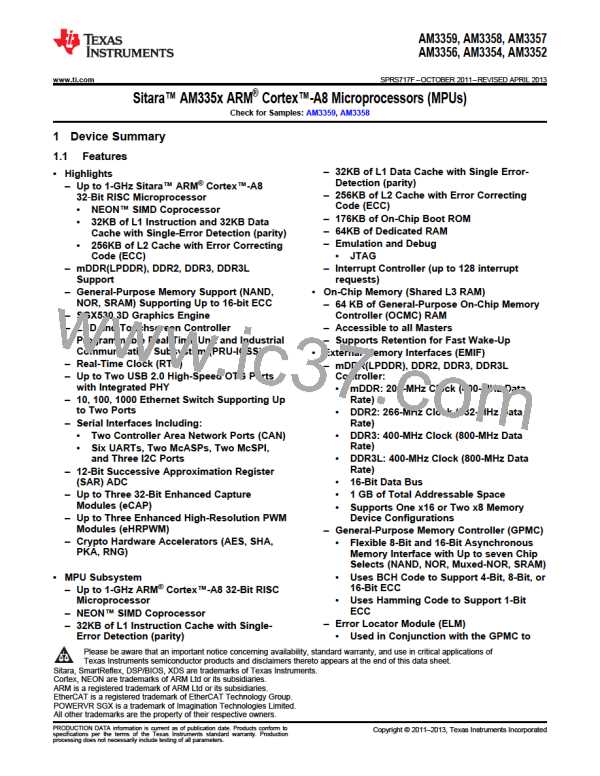AM3359, AM3358, AM3357
AM3356, AM3354, AM3352
SPRS717F –OCTOBER 2011–REVISED APRIL 2013
www.ti.com
4.2.3 Output Clock Specifications
The AM335x device has two clock output signals. The CLKOUT1 signal is always a replica of the OSC0
input clock which is referred to as the master oscillator (CLK_M_OSC) in the AM335x ARM Cortex-A8
Microprocessors (MPUs) Technical Reference Manual (literature number SPRUH73). The CLKOUT2
signal can be configured to output the OSC1 input clock, which is referred to as the 32K oscillator
(CLK_32K_RTC) in the AM335x ARM Cortex-A8 Microprocessors (MPUs) Technical Reference Manual
(literature number SPRUH73), or four other internal clocks. For more information related to configuring
these clock output signals, see the CLKOUT Signals section of the AM335x ARM Cortex-A8
Microprocessors (MPUs) Technical Reference Manual (literature number SPRUH73).
4.2.4 Output Clock Characteristics
NOTE
The AM335x CLKOUT1 and CLKOUT2 clock outputs should not be used as a synchronous
clock for any of the peripheral interfaces because they were not timing closed to any other
signals. These clock outputs also were not designed to source any time critical external
circuits that require a low jitter reference clock. The jitter performance of these outputs is
unpredictable due to complex combinations of many system variables. For example,
CLKOUT2 may be sourced from several PLLs with each PLL supporting many configurations
that yield different jitter performance. There are also other unpredictable contributors to jitter
performance such as application specific noise or crosstalk into the clock circuits. Therefore,
there are no plans to specify jitter performance for these outputs.
4.2.4.1 CLKOUT1
The CLKOUT1 signal can be output on the XDMA_EVENT_INTR0 terminal. This terminal connects to one
of seven internal signals via configurable multiplexers. The XDMA_EVENT_INTR0 multiplexer must be
configured for Mode 3 to connect the CLKOUT1 signal to the XDMA_EVENT_INTR0 terminal.
The default reset configuration of the XDMA_EVENT_INTR0 multiplexer is selected by the logic level
applied to the LCD_DATA5 terminal on the rising edge of PWRONRSTn. The XDMA_EVENT_INTR0
multiplexer is configured to Mode 7 if the LCD_DATA5 terminal is low on the rising edge of PWRONRSTn
or Mode 3 if the LCD_DATA5 terminal is high on the rising edge of PWRONRSTn. This allows the
CLKOUT1 signal to be output on the XDMA_EVENT_INTR0 terminal without software intervention. In this
mode, the output is held low while PWRONRSTn is active and begins to toggle after PWRONRSTn is
released.
4.2.4.2 CLKOUT2
The CLKOUT2 signal can be output on the XDMA_EVENT_INTR1 terminal. This terminal connects to one
of seven internal signals via configurable multiplexers. The XDMA_EVENT_INTR1 multiplexer must be
configured for Mode 3 to connect the CLKOUT2 signal to the XDMA_EVENT_INTR1 terminal.
The default reset configuration of the XDMA_EVENT_INTR1 multiplexer is always Mode 7. Software must
configure the XDMA_EVENT_INTR1 multiplexer to Mode 3 for the CLKOUT2 signal to be output on the
XDMA_EVENT_INTR1 terminal.
114
Power and Clocking
Copyright © 2011–2013, Texas Instruments Incorporated
Submit Documentation Feedback
Product Folder Links: AM3359 AM3358 AM3357 AM3356 AM3354 AM3352

 TI [ TEXAS INSTRUMENTS ]
TI [ TEXAS INSTRUMENTS ]